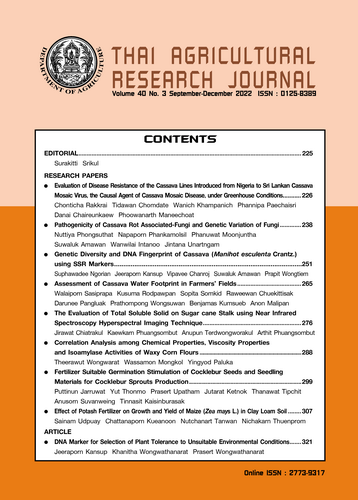Pathogenicity of cassava rot diseases and genetic variation of fungi
DOI:
https://doi.org/10.14456/thaidoa-agres.2022.20Keywords:
Cassava, root rot, tuber ro, stem rot, ISSRAbstract
Cassava (Manihot esculenta Crantz) is one of the important economic crops of Thailand. The root rot, tuber rot and stem rot diseases caused by fungal pathogens are the main problems of cassava production. The purposes of this research were to study the pathogenicity of rot diseases fungi and to evaluate their genetic variability. Cassava diseases survey was conducted, infected roots, tubers and stems were collected. Soils around diseased plants were sampled at 3 depth levels i.e. 0-20, 20-40 and 40-60 centimeters. Morphological characteristics-based identification was done and pathogenicity test was observed in Rayong 9 variety by inoculating with 12 isolates of Fusarium spp., Pythium spp., and Neoscytalidium sp. Results revealed that Fusarium spp. and Neoscytalidium sp. were related to disease occurrence on Rayong 9 variety after 5 months of inoculation. When the isolates of Fusarium spp. and Neoscytalidium sp. were analysed at ITS rDNA region and nucleotide sequences of RPB2 and Tef -1a genes for Fusarium species identification, results indicated that the isolates were identified as N. dimidiatum, F. incarnatum and F. solani. Moreover, the genetic variability was observed by ISSR markers in N. dimidiatum (20 isolates), F. incarnatum (16 isolates), and F. solani (13 isolates). Results showed that there were variations both within fungal population and among populations from different cassava fields.
References
จินตนา อันอาตม์งาม. 2562. เทคนิควิจัยเชื้อราสาเหตุโรคพืช. สำนักพิมพ์ศูนย์ส่งเสริมและฝึกอบรมการเกษตรแห่งชาติ มหาวิทยาลัยเกษตรศาสตร์ วิทยาเขตกำแพงแสน นครปฐม. 166 หน้า.
ชนม์นิภา ดีวงษ์. วนิดา ธรรมธุระสาร และจินตนา อันอาตม์งาม. 2564. การประเมินความผันแปรทาง พันธุกรรมของเชื้อรา Sarocladium oryzae สาเหตุโรคกาบใบเน่าสายพันธุ์ต่างๆ ในประเทศไทย ด้วยเครื่องหมาย ISSR. ว.วิทยาศาสตร์เกษตรและการจัดการ. 4(1): 13-20.
ชาติชาย ศิริพัฒน์. 2557. รากเน่าหัวเน่าระบาดหนักในไร่มันสำปะหลัง. แหล่งข้อมูล:http://www.thairath.co.th/content/442798. สืบค้น: 19 มีนาคม 2564.
ฐิติมา วีระศิลป์. 2542. โรคมันสำปะหลังพืชทองคำใต้แผ่นดินมันสำปะหลัง. วิทยานิพนธ์วิทยาศาสตรมหาบัณฑิต. มหาวิทยาลัยเกษตรศาสตร์. กรุงเทพฯ. 41-121 หน้า.
เบญจพล ศรีทองคํา. 2559. ลักษณะทางสัณฐานวิทยาและอณูวิทยาของเชื้อรา Fusarium species ที่แยกจากพืชเป็นโรค. วิทยานิพนธ์มหาบัณฑิต ภาควิชาโรคพืชคณะเกษตร มหาวิทยาลัยเกษตรศาสตร์ นครปฐม. 126 หน้า.
พรปวีณ์ ธิวัฒน์วรานิกุล ภาณุวัฒน์ มูลจันทะ วรรณวิไล อินทนู และจินตนา อันอาตม์งาม. 2561. การวิเคราะห์ลายพิมพ์ดีเอ็นเอและการก่อให้เกิดโรคเน่าแห้ง-เน่าดำมันสำปะหลังที่เกิดจากเชื้อรา Fusarium solani และ Neoscytalidium hyalinum. ว.วิทยาศาสตร์เกษตรและการจัดการ. (2): 22-34.
พรปวีณ์ ธิวัฒน์วรานิกุล ภาณุวัฒน์ มูลจันทะ วรรณวิไล อินทนู และจินตนา อันอาตม์งาม. 2562. การจำแนกชนิดและการก่อโรคของเชื้อราสาเหตุโรคหัวเน่ารากเน่าและต้นเน่าของมันสำปะหลัง. ว. เกษตรพระจอมเกล้า. 37(2): 239-249.
พรพิมล อธิปัญญาคม สุณีรัตน์ สีมะเดื่อ ชนินทร ดวงสอาด และอมรรัชฏ์ คิดใจเดียว. 2562. การศึกษาเชื้อสาเหตุโรคโคนเน่าและรากเน่าของมันสำปะหลังโดยใช้ลักษณะทางสัณฐานวิทยาและข้อมูลทางชีวโมเลกุล. ว.วิชาการเกษตร. 37(3): 307-319.
ศูนย์วิจัยพืชไร่นครสวรรค์. 2554. ระวัง...การระบาดของโรคในมันสำปะหลัง. แหล่งข้อมูล: http://nsfcrcnews.blogspot.com/2011/06/blog-post.html. สืบค้น : 23 กุมภาพันธ์ 2564.
สุทธิสา ดัชนีย์. 2558. การระบุเชื้อราสาเหตุโรคต้นและรากเน่าดำของมันสำปะหลัง. วิทยานิพนธ์ ปริญญา วิทยาศาสตร์มหาบัณฑิต สาขาเทคโนโลยีการผลิตพืช, มหาวิทยาลัยเทคโนโลยีสุรนารี. 130 หน้า.
สำนักงานเศรษฐกิจการเกษตร. 2564. มันสำปะหลังโรงงาน : ข้อมูลการผลิตสินค้าเกษตร ปี 2564. แหล่งข้อมูล: https://www.oae.go.th. สืบค้นเมื่อ: 10 มีนาคม 2565.
อมรรัตน์ ภู่ไพบูลย์. 2556. พืชที่เป็นโรคไฟทอปธอรา. เอกสารวิชาการ สำนักวิจัยพัฒนาการอารักขาพืช. กรมวิชาการเกษตร กระทรวงเกษตรและสหกรณ์. กรุงเทพฯ. 189 หน้า.
Boas, S.A.V., S.A.S.D. Oliveira., C.A.D. Braganca., J.B. Ramos and E.J.D. Oliveira. 2017. Survey of fungi associated with cassava root rot from different producing regions in Brazil. Sci. agric. 74(1): 60-67.
Charaensatapon, R., T. Saelee, U. Chulkod and S. Cheadchoo. 2014. Phytophthora Root and Tuber of cassava in Thailand. Field and renewable energy crops research institute. Department of agriculture, Thailand. In Proceedings of 5th Asian Conference on Plant Pathology. Chiang Mai, Thailand. 3-6 November.
Felsenstein, J. 1985. Confidence limits on phylogenies: An approach using the bootstrap. Evolution. 39(4): 783-791.
Geiser, D.M., M. del Mar Jimenez Gasco, S. Kang, I. Makalowska, N. Veeraraghavan, T.J. Ward, N.Zhang, G.A. Kuldau and K.O' donnell. 2004. FUSARIUM-ID v. 1.0: DNA sequence database for identifying Fusarium. Eur. J. Plant. Pathol. 110 (5-6): 473-479.
Hofstetter, V., M. Jolanta, K. Frank and L. François. 2007. Phylogenetic comparison of protein-coding versus ribosomal RNA-coding sequence data: A case study of the Lecanoromycetes (Ascomycota). Mol. Phylogenet Evol. 44(1). 412–426.
Larkin, M.A., G. Blackshields, N.P. Brown, R. Chenna, P.A. McGettigan, H. McWilliam, F. Valentin, I.M. Wallace, A. Wilm, R. Lopez, J.D. Thompson, T.J. Gibson and D.G. Higgins. 2007. ClustalW and ClustalX version 2. Bioinformatics 23(21): 2947-2948.
Msikita, W., B. James, M. Ahounou, H. Baimey, B.G. Facho and R. Fagbemissi. 1998. Discovery of new diseases of cassava in West Africa. Tropical Agriculture. 75 (1/2): 58-63.
Nei, M. and S. Kumar. 2000. Molecular Evolution and Phylogenetics. Oxford University Press, New York. 348 p.
Onyeka, T.J., E.J.A. Ekpo and A.G.O. Dixon. 2004. Cassava root rot disease in West Africa: Review of recent literature and the field situation in Nigeria. In Root crops in the 21st century, pp. 584-588. In: Proceedings of the 7th Triennial Symposium of the International Society of the Tropical Root Crops Africa Branch (ISTRC-AB). ISTRC-AB/IITA. Ibadan, Nigeria.
Sneath, P.H.A. and R.R. Sokal. 1973. Numerical Taxonomy. The Principles and Practice of Numerical Classification. WF Freeman & Co., San Francisco. 573 p.
Tamura, K., G. Stecher, and S. Kumar 2021. MEGA 11: Molecular Evolutionary Genetics Analysis Version 11. Mol. Biol. Evol. 38(7): 3022–3027.
White, T.J., T. Bruns, S. Lee and J.W. Taylor. 1990. Amplification and direct sequencing of fungal ribosomal RNA genes for phylogenetics. pp. 315-322. In: PCR protocols: A Guide to Methods and Applications. Academic Press, New York,
Downloads
Published
How to Cite
Issue
Section
License
Copyright (c) 2022 Thai Agricultural Research Journal

This work is licensed under a Creative Commons Attribution-NonCommercial-NoDerivatives 4.0 International License.
Thai Agricultural Research Journal



